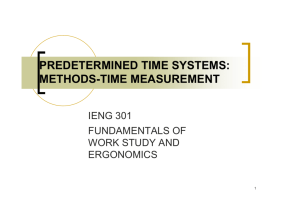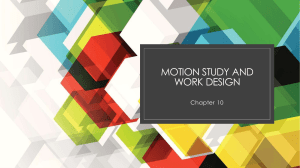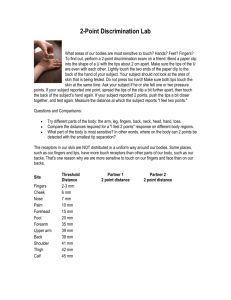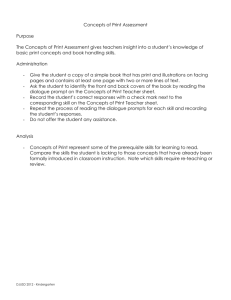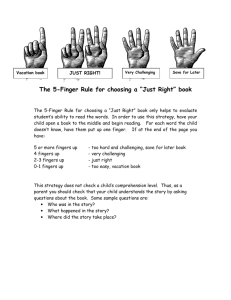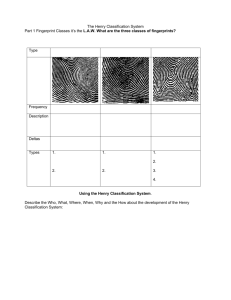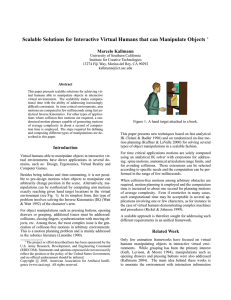Two-Handed Process Chart: Motion Study & Workplace Design
advertisement
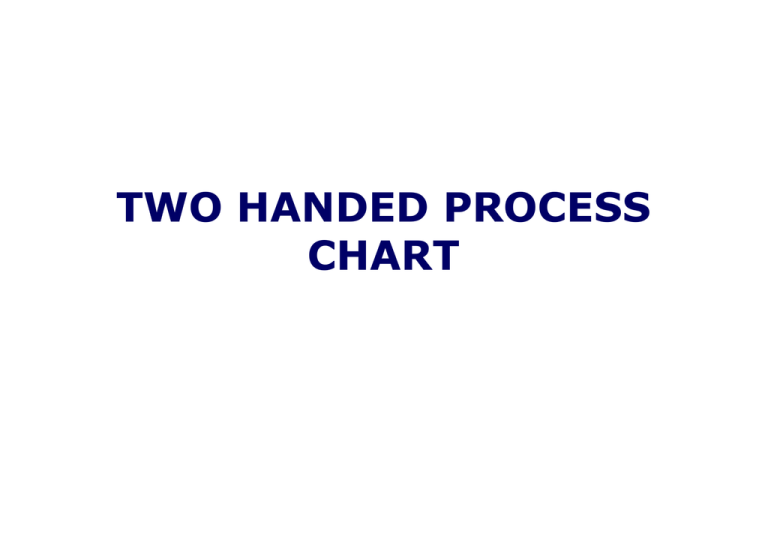
TWO HANDED PROCESS CHART DEFINITION: A chart in which the activities of a worker’s hands (or limbs) are recorded in their relationship to one another. Generally used for repetitive operation, when one complete cycle of the operation is to be recorded Two Handed Process Chart Symbols OPERATION TRANSPORT Used for the activities of grasp, position, use, release of tool, component or material. Used to represent the movement of the hand (or limb) to or from the work, a tool or material CONTINUED HOLD (STORAGE) DELAY Used to represent the activity of holding the work, a tool or material Used to denote time during which the hand or limb being charted is idle BARNES’ MOTION STUDY PRINCIPLES • The two hands should begin as well as complete their motions at the same time. • The two hands should not be idle at the same time except during rest periods. • Motions of the arms should be made in opposite and symmetrical directions and should be made simultaneously. CONTINUED • Materials and tools should be located to permit the best sequence of motions. • Hand and lower arm movements are preferred to upper arm and shoulder movement for light work • Rhythm is essential to smooth, automatic performance. • Tool, materials and controls should be located close to and directly in front of the operator. CONTINUED • Gravity feed bins and containers should be used to deliver materials close to the point of use. • Drop deliveries should be used wherever possible. • The hands should be relieved of all work that can be done by a jig, fixture or a foot operated device. • Smooth continuous motions of the hands are preferable to straight-line or zigzig motion involving sudden and sharp change in direction. Classification of movements Class Pivot Body member(s) moved 2 Hand and Fingers 1 Knuckle 3 Elbow 4 5 Wrist Finger Forearm, hand and fingers Shoulder Upper arm, forearm,hand,fingers Trunk Torso, upper arm, forearm, hand, fingers ARRANGEMENT OF THE WORKPLACE • Definite and fixed stations should be provided for all tools and materials to permit habit formation. • Tools and materials should be pre-positioned to reduce searching. • Gravity feed, bins and containers should be used to deliver the materials as close to the point of use CONTINUED • Tools, materials and controls should be located within the maximum working area and as near to the worker • Materials and tools should be arranged to permit the best sequence of motions. • Drop deliveries” or ejectors should be used so that the operator does not have to use his hands to dispose of the finished work. CONTINUED • Provision should be made for adequate lighting and a chair of the type and height to permit good posture should be provided. The height of the workplace and seat should be arranged to allow alternate standing and sitting. • The colour of the workplace should contrast with that of the work and thus reduce eye fatigue. DESIGN OF TOOLS AND EQUIPMENT • Hands should be relieved of all work of “holding” if this can be done by a jig, fixture or foot-operated device. • Combine tool wherever possible. • Where each finger performs some specific movement, the load should be distributed in accordance with the inherent capacities of the fingers. CONTINUED • Handles such as on cranks and large screwdrivers should be designed for maximum surface of the hand come into contact with it. This is necessary when considerable force has to be used on the handle. • Levers and hand wheels should be place so operator can use them with the least change in body position and the greatest “mechanical advantage”. MAXIMUM WORKING AREA Shoulder movements Left hand maximum working area Normal working area Normal working area Right and maximum working area NORMAL WORKING AREA Finger, wrist and elbow movements Edge of bench THANK YOU
